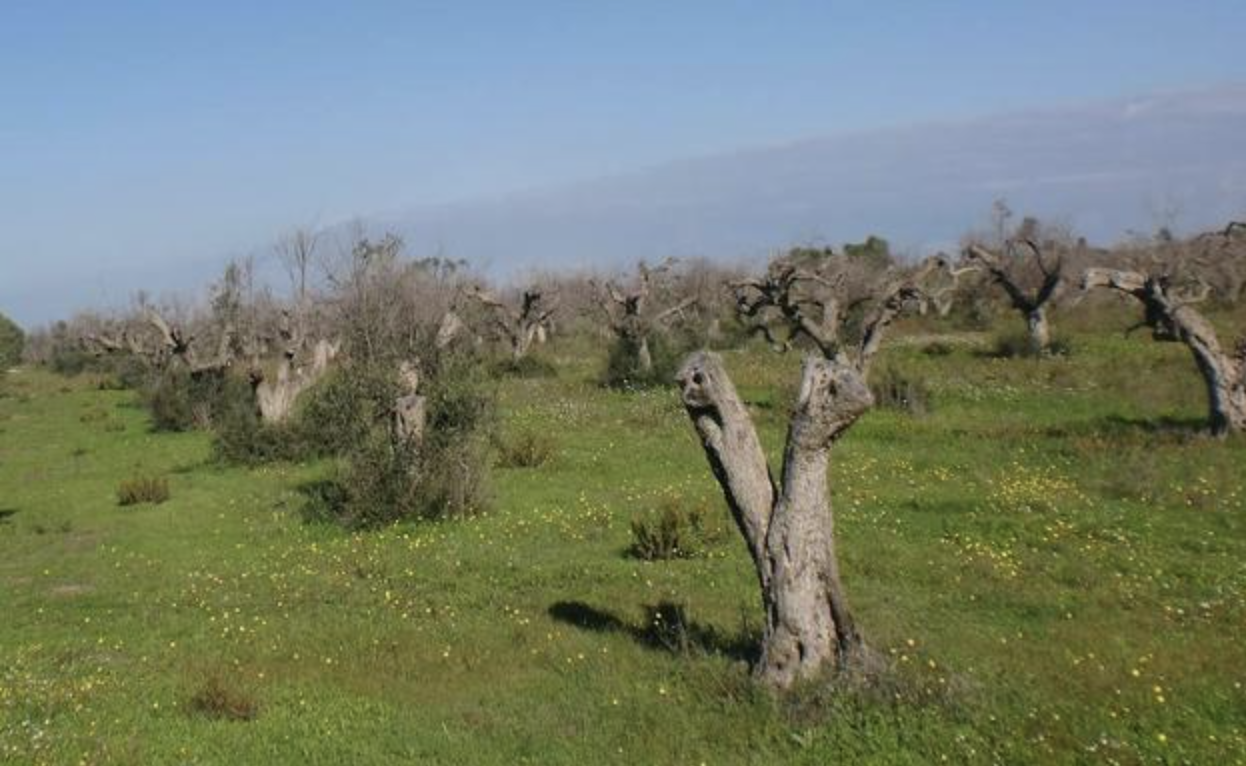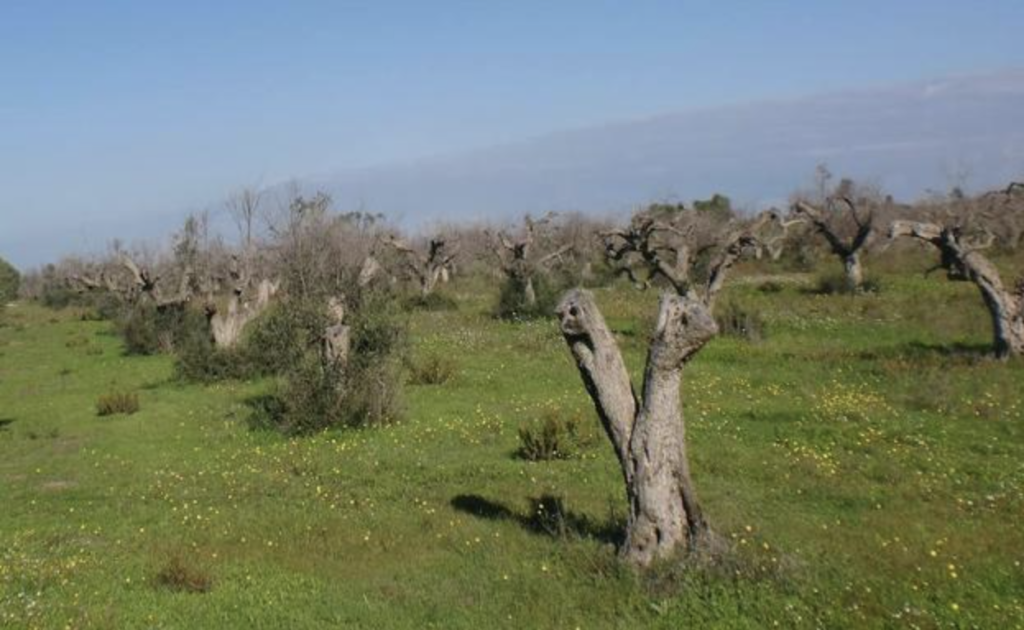 Few issues are of greater concern to the Spanish countryside than the uncontrolled spread of Xylella fastidiosa, as reported by El Confidencial in the article below. It is a bacterium better known as the ‘Ebola of the olive tree’ for its devastating effects on woody plants: olive trees, almond trees, citrus trees and vines are the favourite prey of Xylella, species that happen to be the basis of our agricultural system. A decade ago, Xylella already devastated olive trees in southern Italy, and in the United States, the likely source of this pest, they have resigned themselves to living with it. For some years now, it has been advancing silently through Spain, with its epicentre in Alicante and the Balearic Islands, where it was detected for the first time in 2016 and has devastated crops.
Few issues are of greater concern to the Spanish countryside than the uncontrolled spread of Xylella fastidiosa, as reported by El Confidencial in the article below. It is a bacterium better known as the ‘Ebola of the olive tree’ for its devastating effects on woody plants: olive trees, almond trees, citrus trees and vines are the favourite prey of Xylella, species that happen to be the basis of our agricultural system. A decade ago, Xylella already devastated olive trees in southern Italy, and in the United States, the likely source of this pest, they have resigned themselves to living with it. For some years now, it has been advancing silently through Spain, with its epicentre in Alicante and the Balearic Islands, where it was detected for the first time in 2016 and has devastated crops.
It is a bacterium that obstructs the flow of sap in trees and eventually suffocates them, causing leaves to wilt. Insects that feed on the sap are its vector of transmission, which makes it particularly contagious and unpredictable. Xylella is not only found in olive and almond trees. Xylella is found in a multitude of garden plants, such as rosemary and oleanders, but in many of them it is asymptomatic.
Different research groups are working against the clock to find a remedy to halt its advance. And although everything is in the first laboratory phase, the prospects are good: in a few years’ time, it is very likely that the advance of ‘olive tree ebola’ can be halted by biological treatments. However, to think of eradication would be to delude oneself. Xylella is here to stay and the goal is to minimise damage to agriculture as much as possible.
There are two teams of microbiologists working in parallel. On the one hand, there is the Grupo Operativo Salud Olivar, a conglomerate of olive companies and laboratories from Andalusia, Valencia and Madrid. On the other, there is a team funded by the Valencian Community and led by the renowned microbiologist Francis Mojica together with researchers from the University of Alicante (UA), who focus their study on almond trees. Both teams work on the same basis, although with slight differences.
Enzyme cocktail
The secret to fighting Xylella is called endolysin. In itself, it is nothing new. Endolysins are enzymes produced by bacteriophage viruses that allow these viruses to break down the membranes of bacteria (such as Xylella fastidiosa) and kill them. This is a widely known process. What is new here is that both research groups have been working for months to detect the right enzyme (or protein) cocktail to destroy Xylella, the exact key that opens the lock, and progress is very promising.
«We are halfway there,» warns Paloma Juárez, a researcher at Ainia and one of the leaders of the Olive Health Group. This group has developed a genetically modified strain of Escherichia coli (a bacterium similar to Xylella) capable of producing recombinant endolysins with great potential against Xylella. The key is to be precise, to hit the right key before taking the next step. «These endolysins specifically lyse [destroy] Xylella, but not the microbial consortium around it. We are testing them in ‘in vitro’ trials in the lab, and the next phase will be to test them in the field. There is a long way to go. In the next year, we will continue in the lab, but for now it is working.
The researchers avoid putting a date on the cure for ‘olive tree Ebola’. It will be years, they say, before these endolysins can be synthesised, marketed and made available to farmers. «We are working on a solution for already infected trees, not on a preventive system to apply to all healthy olive trees in a field, because it would be economically unsustainable,» says Juárez.
The application, at present, is as follows: «The endolysins are injected directly into the sap through cannulas into an infected seedling,» says the researcher. «It is something that can be done manually, adjusting the correct input pressure. That is the idea we are considering today, but perhaps we see that foliar application [through the leaves] is more effective, or some other type of application.
The solution, then, will be to cure infected trees so that they don’t have to be uprooted and continue to produce. The rate of transmission of Xylella is so high that it seems unrealistic to think of eradicating it from our fields. Even less so if we bear in mind that the bacterium is constantly mutating and that an effective vaccine for one strain may not be effective for the next. The aim, therefore, is to save the infected trees, which in the case of centuries-old olive trees is no mean feat, through continuous research. Something similar to vaccines for humans, such as the influenza virus vaccine or the more recent covid-19 vaccine.
Jesús García is a microbiologist and co-leader of the team at the University of Alicante. He says there is no «single magic recipe to control the Xylella population», but one of his goals is to find an effective cure against the bacterium’s mutations. «We have synthesised several endolysins present in the genomes of Xylella strains and at the end of the year we will start testing them. The drawback is that the growth rate of this bacterium is slow, much slower than that of Escherichia coli, for example, and this slows down the tests.
The Valencian Community is funding this UA project with 100,000 euros. It started in 2020 and has a four-year study phase. In addition to the work of microbiologists, this research also studies the external elements to minimise the presence of Xylella. César Bordehore, coordinator of the Montgó-Dénia Scientific Station, develops mathematical models to see the weak points of the ecosystems: how effective it is to kill the insect vectors, eliminate grass from the fields or pull up certain plants. «We try to see the impact of each of the measures on the evolution of the disease,» he says.
«The focus is not on eliminating Xylella, but on making it harder for it to enter your target species, for example almond trees. If it is harder for it to enter, there will be less chance of infecting healthy specimens, and we can even slow down the symptoms in infected specimens, so that they can continue to produce despite being infected and we don’t have to uproot that tree and all the others 50 metres around it,» Bordehore explains. «By acting a little bit at each step, removing a little bit of grass, a little bit of insect vectors and reducing the infection rate by 20%, you end up with a drastic reduction. This requires a change of field management model, which is complicated in many areas of Spain.
Both the Olive Health Group and the UA team are currently working on obtaining a stable enzyme cocktail in the laboratory, as there is no point in going out to do field trials without a fully effective product. However, the advances are promising and shed light on a major problem for our crops, the economic impact of which is estimated at billions of euros and threatens olive oil production throughout the Mediterranean.
Source: El Confidencial

